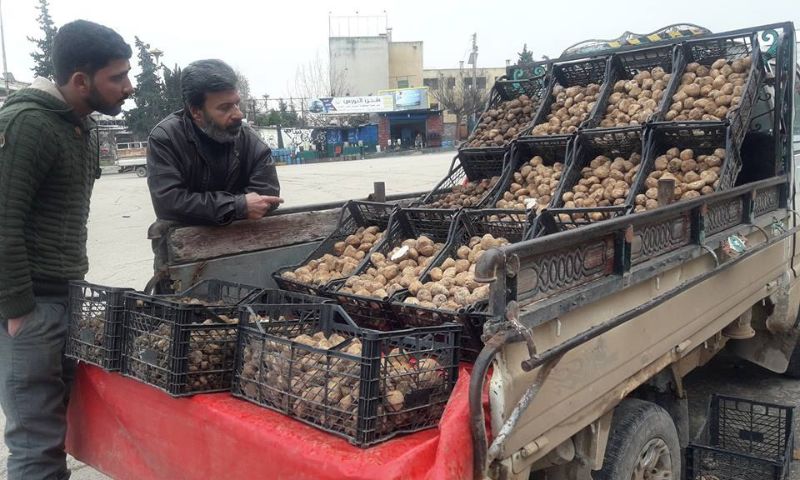Al-Hasakah – Majd al-Salem
Under the difficult economic conditions and the soaring cost of living experienced in the Syrian governorates, truffle hunting season is an “exceptional” opportunity for some to achieve a bumper income with minimal effort.
Khaled al-Jamil, 55, a farmer from the southern countryside of al-Hasakah, told Enab Baladi that “al-Jama” or “al-Faqaa” (a colloquial designation for truffles) was mainly associated with the prevailing weather conditions in the region. The more thunder, lightning, and rain, “the more abundant the season.”
The Jabal Abdul Aziz region and the southern and eastern countryside of al-Hasakah, as well as locations close to the Iraqi borders, are sites where the truffle is widespread. The delayed rains in the current season have affected the abundance of truffles. Although quantities are considered “acceptable,” there is a good chance it will increase in the coming days with the rainfall onset.
Despite the “abundant quantities of truffles” in areas near the Iraqi border, no one can collect it due to the security risks posed by bandits and robbers, along with Iraqi security forces, which consider these areas to be places where elements of the Islamic State (IS) are active, according to al-Jamil.
Chance for additional income
Besides his work in sheep herding within the Badia stretching to Deir Ezzor governorate, Abdel-Baqi al-Ramo; 30, is keen to hunt for truffles nowadays, as he told Enab Baladi.
“Luck” plays a role in finding truffles, an “Allah-handed livelihood.” He may earn from selling them the equivalent of several months’ worth of herding sheep’s pay, said al-Ramo, noting that the difficulty in hunting for it depended on collective work and required one to devote themself for long hours during a day.
It is rare to have someone picking truffles for personal consumption, and most of those picking them have the goal of selling them due to their high prices. As observed by Enab Baladi, the price of 1 kilogram of Zubaidi-type truffles (the designation for the first harvest of truffles) displayed in the market of the town of Markada in the al-Shaddadi region of al-Hasakah amounted to 55,000 SYP.
The dangers of truffle hunting include mines scattered in the area or being robbed during the incursion into the Badia in search of it. Therefore, it is preferable to hunt for truffles in groups, which increases the likelihood that an individual will be hit by a planted mine.
It is no longer a “fun” journey to go out hunting for truffles, as it previously was prior to the beginning of the conflict, after many people lost their lives during their search journey for many reasons, such as attacks by unknown persons or the explosion of landmines and bombs from war remnants.
While the current year has not witnessed any victims, 2022 has seen the abduction of some 20 people. In March 2021, 18 people lost their lives, and others were injured as one of the mines exploded as they picked truffles in the countryside of Salamiyah in the countryside of Hama, and others died for the same reason in Deir Ezzor.
In a report released on April 4, 2022, the Syrian Network for Human Rights (SNHR) stated that 2829 civilians, including 699 children, had been killed by mines in Syria since 2011.
Where and when do truffles appear?
Agronomist and food expert Harith al-Bulabel, 40, told Enab Baladi that truffle mushrooms sprout on protected lands that are not subject to plowing, sowing, fertilization, and other agricultural procedures, which would explain its presence in “natural reserves” such as the region of Jabal Abdul Aziz and in the Badia of Raqqa, al-Hasakah, and Deir Ezzor. The abundance of lightning accompanying the rains is an indication of the “abundance of truffles.”
Truffles are classified into several types according to size and color, such as Zubaidi, Harqa, Hibri, and al-Aswad. On this basis, prices vary, which increase the bigger the truffle is, says al-Bulabel.
According to the agronomist, there are two seasons for truffle hunting based on weather conditions; during winter (November to February) and another short season during the spring in governorates such as Deir Ezzor, which is the main source of truffle. Enab Baladi has not yet spotted any truffle vendors in Qamishli markets.
Truffles are rich in phosphorus, sodium, potassium, and antioxidants and are popular in markets in the Gulf countries, according to the agronomist.

